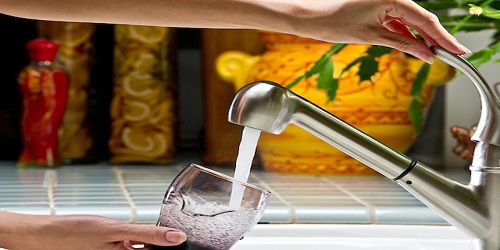Thirst Meaning
The word thirst comes from the Latin term “sitem” and designates a natural and physiological phenomenon by which the body demands the intake of liquids.
The body contains a large proportion of water. In humans, babies have 70% water in their body. Then, as the individual grows and ages, this amount is reduced to 55%. If for some reason water is lost (through urination or sweating) or if salt is ingested, the concentration of sodium increases in the extracellular compartment, which forces the water contained in the cells to leave to compensate for the imbalance. When cellular water decreases, the brain osmoreceptors pick it up, and the sensation of thirst occurs. When drinking, the liquid is absorbed in the intestine, and then enters the bloodstream, restoring the balance.
The causes are: having gone a long time without drinking, or having lost fluids through perspiration or through concentration of osmolytes (solutes that are amino acids, derivatives of them, sugars, salts, etc.).
In diabetics, there is a recurrent and insatiable need to drink, known as polydipsia, due to the large loss of fluid through urine, related to high glucose levels.
The liquid par excellence that quenches thirst and does not harm the body is water, which should be ingested, whether or not you are thirsty, in an amount of 2 liters daily, for adults. You can also quench your thirst with natural fruit and vegetable juices or homemade broths. Industrialized soft drinks, juices or broths are not recommended, as they contain colorants, sugars, salts, and other chemicals.
These are symptoms of thirst: the throat and mouth become dry; and after a certain time, the animal or person who needs to quench their thirst and does not do so, becomes dehydrated, causing neurological and renal complications that, if they persist, could lead to death.
The need for hydration does not decrease with age, but thirst does, so we must be careful to offer, and even force, adults over 50 or 60 years of age to drink water, as they can become dehydrated and not feel the need to drink.
By extension, we also speak of thirst when someone needs to calm their cravings and desires, positive or negative, that cause strong emotions. Examples: “His thirst for revenge led him to commit the most monstrous crimes that humanity has ever witnessed” or “The community, moved by their thirst for justice, demanded that the terrible murderer be condemned before the Court Palace.”
Thirst Meaning in Hindi
प्यास शब्द लैटिन शब्द “साइटम” से आया है और यह एक प्राकृतिक और शारीरिक घटना को दर्शाता है जिसके द्वारा शरीर तरल पदार्थों के सेवन की मांग करता है।
शरीर में पानी का एक बड़ा हिस्सा होता है। मनुष्यों में, शिशुओं के शरीर में 70% पानी होता है। फिर, जैसे-जैसे व्यक्ति बड़ा होता है और उम्र बढ़ती है, यह मात्रा घटकर 55% हो जाती है। यदि किसी कारण से पानी खो जाता है (पेशाब या पसीने के माध्यम से) या यदि नमक का सेवन किया जाता है, तो बाह्य कोशिकीय डिब्बे में सोडियम की सांद्रता बढ़ जाती है, जो असंतुलन की भरपाई के लिए कोशिकाओं में मौजूद पानी को छोड़ने के लिए मजबूर करती है। जब कोशिकीय पानी कम हो जाता है, तो मस्तिष्क ऑस्मोरसेप्टर्स इसे उठाते हैं, और प्यास की अनुभूति होती है। पीने पर, तरल आंत में अवशोषित हो जाता है, और फिर संतुलन को बहाल करते हुए रक्तप्रवाह में प्रवेश करता है।
इसके कारण हैं: लंबे समय तक बिना पिए रहना, या पसीने के माध्यम से या ऑस्मोलाइट्स (अमीनो एसिड, उनके व्युत्पन्न, शर्करा, लवण, आदि) की सांद्रता के माध्यम से तरल पदार्थ खोना।
मधुमेह रोगियों में, बार-बार और कभी न खत्म होने वाली पीने की इच्छा होती है, जिसे पॉलीडिप्सिया के रूप में जाना जाता है, जो उच्च ग्लूकोज स्तर से संबंधित मूत्र के माध्यम से तरल पदार्थ के बड़े नुकसान के कारण होता है।
प्यास बुझाने वाला और शरीर को नुकसान न पहुँचाने वाला सबसे बढ़िया तरल पदार्थ पानी है, जिसे वयस्कों को प्रतिदिन 2 लीटर की मात्रा में पीना चाहिए, चाहे आपको प्यास लगे या न लगे। आप प्राकृतिक फलों और सब्जियों के रस या घर के बने शोरबा से भी अपनी प्यास बुझा सकते हैं। औद्योगिक शीतल पेय, जूस या शोरबा की सिफारिश नहीं की जाती है, क्योंकि उनमें रंग, शर्करा, नमक और अन्य रसायन होते हैं।
प्यास के ये लक्षण हैं: गला और मुँह सूख जाता है; और एक निश्चित समय के बाद, जानवर या व्यक्ति जिसे अपनी प्यास बुझाने की ज़रूरत होती है और वह ऐसा नहीं करता है, निर्जलित हो जाता है, जिससे न्यूरोलॉजिकल और गुर्दे संबंधी जटिलताएँ होती हैं, जो अगर बनी रहती हैं, तो मृत्यु का कारण बन सकती हैं।
उम्र बढ़ने के साथ हाइड्रेशन की ज़रूरत कम नहीं होती, लेकिन प्यास कम होती है, इसलिए हमें 50 या 60 साल से ज़्यादा उम्र के वयस्कों को पानी पीने के लिए देने और यहाँ तक कि उन्हें मजबूर करने में सावधानी बरतनी चाहिए, क्योंकि वे निर्जलित हो सकते हैं और उन्हें पानी पीने की ज़रूरत महसूस नहीं होगी।
विस्तार से, हम प्यास की बात तब भी करते हैं जब किसी को अपनी इच्छाओं और इच्छाओं को शांत करने की ज़रूरत होती है, चाहे वे सकारात्मक हों या नकारात्मक, जो मजबूत भावनाओं का कारण बनती हैं। उदाहरण: “बदला लेने की उसकी प्यास ने उसे सबसे भयानक अपराध करने के लिए प्रेरित किया जो मानवता ने कभी देखा है” या “न्याय की अपनी प्यास से प्रेरित समुदाय ने मांग की कि भयानक हत्यारे को कोर्ट पैलेस के सामने दोषी ठहराया जाए।”

